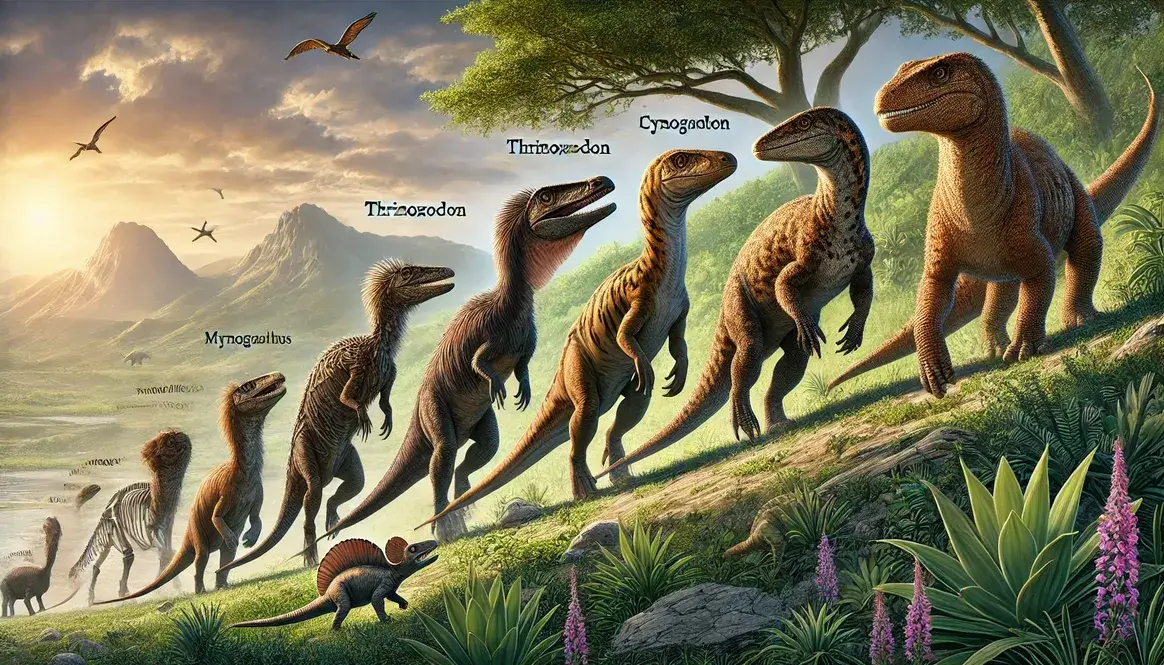The End-Triassic Extinction Event marked a pivotal moment in Earth’s history, occurring approximately 201 million years ago. This global catastrophe brought the Triassic Period to a close and ushered in the Jurassic Period, reshaping life on our planet.
So, what killed the Triassic dinosaurs? The primary culprit was a combination of massive volcanic eruptions and the resulting climate change. These factors led to widespread environmental disruption, including atmospheric changes, ocean acidification, and habitat loss, which proved fatal for many Triassic species, including early dinosaurs.
Major Causes of the Triassic-Jurassic Extinction
The End-Triassic extinction wasn’t caused by a single event, but rather a complex interplay of geological and environmental factors. Let’s explore the main contributors to this mass extinction.
Volcanic Activity: The Central Atlantic Magmatic Province
The Central Atlantic Magmatic Province (CAMP) played a crucial role in the End-Triassic extinction. This enormous igneous province formed as Pangaea began to break apart, resulting in one of the largest known volcanic events in Earth’s history.
CAMP’s key features include:
- Size: Covered an area of about 11 million square kilometers
- Duration: Volcanic activity lasted for approximately 600,000 years
- Location: Stretched across what is now North America, South America, Africa, and Europe
The impact of CAMP on the global climate and environment was profound:
- Atmospheric changes: Massive amounts of carbon dioxide and sulfur dioxide were released into the atmosphere.
- Global warming: The greenhouse effect caused by these gases led to a significant increase in global temperatures.
- Acid rain: Sulfur dioxide emissions resulted in widespread acid rain, damaging terrestrial ecosystems.
- Ocean acidification: Increased atmospheric CO2 led to higher absorption by the oceans, making them more acidic.
Climate Change and Its Consequences
The volcanic activity from CAMP triggered rapid and severe climate change, with far-reaching consequences for both terrestrial and marine ecosystems.
Effects of rapid warming on ecosystems:
| Ecosystem | Impact |
|---|---|
| Terrestrial | Plant die-offs, habitat loss, food chain disruptions |
| Marine | Coral reef collapse, plankton decline, oxygen depletion |
Changes in ocean chemistry and atmospheric composition:
- Ocean acidification: Made it difficult for marine organisms to build and maintain calcium carbonate shells and skeletons
- Atmospheric CO2 levels: Increased from about 2,000 ppm to 4,400 ppm
- Global temperature rise: Estimated increase of 3-6°C over several thousand years
Other Potential Factors
While volcanic activity and climate change were the primary drivers of the End-Triassic extinction, other factors may have contributed to the event’s severity.
Possibility of extraterrestrial impact:
Some researchers have proposed that an asteroid or comet impact may have played a role in the extinction. However, evidence for such an impact remains limited and controversial. Unlike the end-Cretaceous extinction, no clear impact crater from this time period has been identified.
Sea level changes and habitat loss:
Fluctuations in sea level during the Late Triassic and Early Jurassic also contributed to habitat loss and ecosystem disruption:
- Rising sea levels flooded coastal areas, eliminating terrestrial habitats
- Falling sea levels exposed and destroyed shallow marine environments
- These changes forced many species to adapt quickly or face extinction
Impact on Dinosaur Populations
The End-Triassic extinction had a significant impact on early dinosaur populations, though the group as a whole survived and went on to dominate terrestrial ecosystems in the Jurassic Period.
Affected Dinosaur Groups
Early theropods and their fate:
Theropods, the primarily carnivorous group of dinosaurs, experienced significant losses during the extinction event. Several early theropod families went extinct, including:
- Coelophysoids
- Some early neotheropods
However, some theropod lineages survived and diversified in the Early Jurassic, eventually giving rise to more advanced forms like allosauroids and tyrannosaurs.
Prosauropods and other early dinosaur lineages:
Prosauropods, the early relatives of sauropods, were also affected by the extinction:
- Many prosauropod genera went extinct
- Some lineages survived and evolved into the first true sauropods in the Early Jurassic
- Other early dinosaur groups, like primitive ornithischians, experienced similar patterns of extinction and survival
Regional Variations in Extinction Patterns
The impact of the End-Triassic extinction wasn’t uniform across the globe. Some regions experienced higher extinction rates than others, leading to variations in survival patterns.
Differences in extinction rates across geographical areas:
| Region | Extinction Severity |
|---|---|
| Europe | High |
| North America | Moderate to High |
| South America | Moderate |
| Asia | Lower |
| Gondwana | Variable |
Possible reasons for these variations:
- Local climate conditions: Some areas may have experienced less severe climate change
- Geographic barriers: Mountains or bodies of water may have provided refugia for some species
- Ecosystem resilience: Certain regions may have had more diverse or adaptable ecosystems
- Proximity to CAMP: Areas closer to the volcanic activity likely experienced more severe effects
These regional variations played a crucial role in shaping the post-extinction recovery and the evolution of dinosaurs in the Jurassic Period. For more information on how dinosaurs adapted to different environments, check out our article on dinosaur habitats.
Effects on Other Triassic Life Forms
The End-Triassic extinction event wasn’t exclusive to dinosaurs; it had far-reaching consequences for a wide range of Triassic life forms, both in the oceans and on land.
Marine Life Devastation
The once-thriving marine ecosystems of the Late Triassic faced significant disruptions and losses. Triassic sea creatures bore the brunt of these changes, with many groups suffering heavy losses:
- Marine reptiles: Placodonts and nothosaurs went extinct, while many ichthyosaur species disappeared.
- Invertebrates: Approximately 20% of marine families vanished, including the complete extinction of conodonts.
The extinction reshaped marine ecosystems in several ways:
- Reef collapse
- Food web disruption
- Dominance shifts among surviving species
- Extended recovery period
Terrestrial Plant and Animal Casualties
On land, the story was equally grim. Triassic plants faced unprecedented challenges, with up to 95% of plant species in Europe going extinct. Seed ferns were particularly hard hit, while conifers and ferns showed higher survival rates.
Non-dinosaurian reptiles and early mammal relatives also felt the impact:
- Phytosaurs – extinct
- Many therapsid lineages – disappeared
- Triassic mammal ancestors – faced significant challenges, but some groups survived
Survivors and Post-Extinction Diversification
Despite the severity of the End-Triassic extinction, some groups managed to survive and thrive in its aftermath.
Dinosaur Lineages That Persisted
Several dinosaur lineages made it through the extinction event, setting the stage for their Jurassic dominance. Characteristics that may have aided their survival include adaptability, diverse diets, efficient respiratory systems, and relatively small body sizes.
The surviving dinosaurs experienced rapid diversification in the Early Jurassic:
“Theropods evolved into new forms, including larger predators. Sauropodomorphs began their journey towards gigantism. Early ornithischians gave rise to more diverse herbivorous groups.”
This radiation laid the foundation for the incredible diversity of dinosaurs seen throughout the Jurassic and Cretaceous periods.
Other Survivors and Their Subsequent Evolution
Dinosaurs weren’t alone in their survival and subsequent thriving. Crocodylomorphs, ancestors of modern crocodiles, diversified into various forms, including fully marine species. Pterosaurs also survived and went on to evolve into larger and more diverse forms in the Jurassic.
The extinction of many Triassic species left ecological niches open for survivors to exploit. Some mammal lineages evolved to fill small insectivore and omnivore roles, certain reptile groups adapted to aquatic lifestyles, and plants evolved new strategies for pollination and seed dispersal.
Lessons from the End-Triassic Extinction
The End-Triassic extinction event offers valuable insights into the nature of mass extinctions and their long-term impacts on Earth’s ecosystems. It demonstrates:
- The combined effect of multiple environmental stressors
- The extended time required for ecosystem recovery
- The creation of evolutionary opportunities for surviving groups
- The vulnerability of Earth’s ecosystems to rapid climate change
By studying events like the End-Triassic extinction, we gain a better understanding of how past climates and ecosystems changed. The Triassic climate and its changes offer valuable lessons for interpreting modern climate data and predicting future trends.
Understanding these ancient extinction events also helps us appreciate the resilience and adaptability of life on Earth. From the ashes of the End-Triassic extinction arose the diverse and fascinating world of the Jurassic, setting the stage for one of the most iconic periods in Earth’s history.
For a broader perspective on the Triassic world and how it changed over time, explore our article on what Earth was like in the Triassic.









